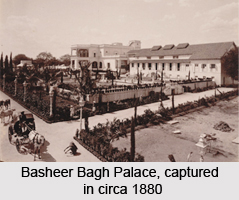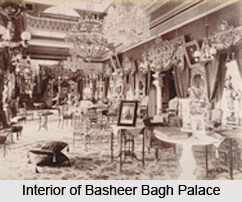 Basheer Bagh Palace, or the Bashir Bagh Palace, was a palace situated in the capital city of Hyderabad of the present day Telangana. An erstwhile regal palace, it was erected in the later half of the 19th century, by Sir Asman Jah, a noble belonging to the Paigah senior aristocratic family of Hyderabad at the time of British Raj, who was also the Prime Minister of the princely state from 1887 to 1894, under the Nizams. The Paigah family was courteously respected by the Nizam kings during the time.
Basheer Bagh Palace, or the Bashir Bagh Palace, was a palace situated in the capital city of Hyderabad of the present day Telangana. An erstwhile regal palace, it was erected in the later half of the 19th century, by Sir Asman Jah, a noble belonging to the Paigah senior aristocratic family of Hyderabad at the time of British Raj, who was also the Prime Minister of the princely state from 1887 to 1894, under the Nizams. The Paigah family was courteously respected by the Nizam kings during the time.
Historical Facts of Basheer Bagh Palace
Basheer Bagh Palace once showcased splendid architecture with magnificent interior and facilities. The palace held the distinction of playing host to the Hindustani classical maestro, Ustad Bade Ghulam Ali Khan, who had stayed in the palace in the final years of his life, patronised by Nawab Zahir Yar Jung, one of the Nizam rulers of Hyderabad. Ustad Bade Ghulam Ali Khan breathed his last at this palace, on April 25, 1968.
Basheer Bagh Palace was dismantled by the State Government of Andhra Pradesh, after the formation of the state post Indian independence, in the year 1956. Neither any traces of the palace nor the bagh are in existence anymore, except in the chronicles of history and in pictures, although the name Basheerbagh is still in use today, to describe the site.
This article is a stub. You can enrich by adding more information to it. Send your Write Up to content@indianetzone.com
Related Articles:
Palaces of India
Palaces of Telangana
Hyderabad
Telangana
Paigah Tombs, Andhra Pradesh
Monuments Of Hyderabad, Monuments Of Andhra Pradesh
Princely States of India
Ustad Bade Ghulam Ali Khan
Nizams of Hyderabad
History of Hyderabad



















